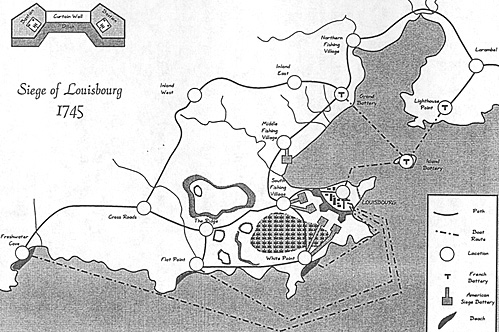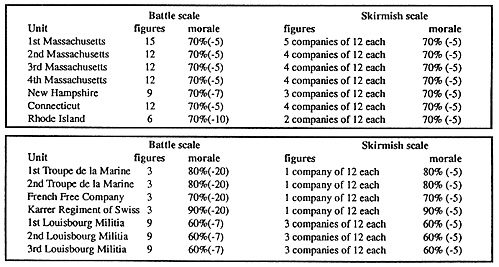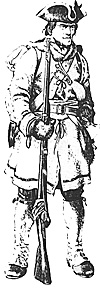 The following is a short campaign game for Habitants and Highlanders. Although almost all horse and musket game could be used with some tinkering. The players will need a photocopy of the map, paper and pen, a cardboard counter for each regiment and leader, as well as one American artillery marker and three French artillery markers. There should also be 2 decoys for the Americans and 3 decoys for the French.
The following is a short campaign game for Habitants and Highlanders. Although almost all horse and musket game could be used with some tinkering. The players will need a photocopy of the map, paper and pen, a cardboard counter for each regiment and leader, as well as one American artillery marker and three French artillery markers. There should also be 2 decoys for the Americans and 3 decoys for the French.
 GENERAL PEPPERAL's BRIEFING (AMERICAN)
GENERAL PEPPERAL's BRIEFING (AMERICAN)
Since they attacked the English fishing station at Canseau last summer, you have been waiting to rid the North Atlantic of these French privateering dogs. Now from the deck of your transport you can seethe spires of Louisbourg. If the British army won't weed out these vermin then, by God, the good men of New England will!!!
- General William Pepperal (1) (Efficient)
Major William Vaughan (2) (Efficient)
Major Joshua T itcomb (3) (Plodding)
GOVERNOR DU CHAMBON's BRIEFING (FRENCH)
You have been assured by Versailles, over-and-over again, that if war came the Americans could not launch an assault without consent from London. Six months notice is what the King's ministers said you would get before an army showed up in Gabarus Bay. And yet from the your study in the Governor's mansion, you can count 100 masts. Prepare to defend the "Gibraltar of the Atlantic".
- Governor du Chambon (1) (Plodding)
Capitaines de la marine d'Ailleboust (2) (Plodding)
Capitaines de la cote Beaubassin (3) (Efficient)
DeploymentP
The French player deploys his troops on any of the locations on the map. The American player then notes which of the three beaches; Freshwater Cove, Flat Point or White Point; he intends to land on.
PLAY
Each turn both players secretly note their move on a paper. In one turn, a player can move any or all of the regiments and leaders at one location to one other location connected by a path or boat route. Only one such move can be made each turn. Instead of moving, the American player may attempt to establish a siege artillery gallery or assault Louisbourg. Once the moves have been noted, the players reveal their moves to each other and then place their markers, face down, on the appropriate locations. If two opposing forces end up in the same area, the player whose troops did not just move into that area may retreat to any friendly adjoining area, if he so wishes. If both forces just arrived or two enemies crossed paths then the French player states first if he wishes to remain and, if he does, the American player has the option to withdraw. In either case if both players wish to remain in the location the battle is resolved using miniatures. Use some appropriate form of random terrain set up. Remembering that the terrain around Louisbourg is generally flat with sprucebrush or bog. After the battle the loser must retreat to an adjoining friendly location. If he cannot, all the troops are captured and removed from the game. Both sides retain all their casualties throughout the entire campaign.
VICTORY CONDITIONS
To win the American player must have establishes at least 3 siege galleries, after 20 turns or have successfully stormed the walls of Louisbourg. If the American player fails to achieve his victory conditions, the French player wins.
Special. Rules
1. Leaders, Movement and Combat
Leaders are ranked (1, 2 and 3). 1 is the highest ranked leader, 2 is second in command and 3 is the lowest level leader. The highest ranked leader commands all friendly units at his location. Lower level leaders at this location are ignored. Regiments may not be move unless a leader moves with them. Leaders use a command check appropriate for their quality if they are commanding in battle. Regiments in battle without a leader use a "Buffoon" card deck. Decoys may move without a leader, but are removed from the game if discovered alone by the enemy.
2. Landings
On the first turn of the game the American must move onto the assigned beach. If there are no French troops on the beach or if the Americans succeed in driving the enemy off the location then the whole army starts turn 2 with this location as its supply stage. If the beach is defended by any French troops, each of the seven American regiments attempting a landing must a ten-sided die on the following Opposed Landing Chart.
- OPPOSED LANDING CHART
1-5 Regiment lands safely.
6-8 Boats capsize. The troops survive but none have dry power and so cannot fire their weapons for the rest of that battle. They may melee with bayonet, however.
9-10 The boats are smashed against the rocks: regiment is lost.
If the Americans do not succeed winning a location for their supply base on the first turn, the game is a French victory.
3. Locations and Boat Routes
All locations are French owned at the beginning of the game. Once an American force enters the location it is considered American owned until such time as a French force ends a turn there. Only French troops may use the boat routes extending to and from Louisbourg. Any time the American attempts to land on the Island Battery location, he rolls on the Opposed Landing Chart (see special rule 2 above) for each American regiment involved, if there are French troops already on that location.
 4. Siege Galleries
4. Siege Galleries
Instead of making a move, the American Player may attempt to establish a siege gallery if he has an unused artillery marker in his possession. He rolls a 10-sided die and on a roll of 1, 2 or 3, the gallery is established. He then places his marked on any siege artillery gallery connected to a location he controls. Note that the Americas player only has one artillery marker to start the game, so he must capture French artillery markers by taking the Grand Battery, the Island Battery or Lighthouse Point. If the location to which the siege gallery is connected is subsequently recaptured by the French, the artillery within the gallery is removed from the game permanently.
5. Supply
At the end of each turn, each regiment that cannot trace a supply line of friendly locations from their position to their base of supply, loses 1 figure if playing the battle scale or 4 figures if playing the skirmish scale. The French base of supply is Louisbourg. The American base of supply is the beach they landed on.
6. Assaulting the Walls of Louisbourg
If the American player has at least one siege gallery established which is connected to the South Fishing Village or White Point locations he may assault the fortress, with the troops in that location, by noting this as his move, in the normal fashion. If there are no French troops in Louisbourg, he wins the game. If the French have troops within, set up a 12" section of curtain wall, with a Bastion at each end and a 2" wide ditch in front. Each bastion holds a heavy gun (aimed 45° toward the centre of the curtain wall) with two crew figures. For skirmish games, the curtain wall should be 36" long, the ditch 6" wide and the artillery should have 3 guns with two crew figures each.
The ditch costs one action to descend into and the curtain wall takes one action to scale. Bastion walls cannot be scaled. The French player places all the troops he has in Louisbourg on the curtain wall or in the bastions. The American Player places all his troops at least 6" from the edge of the ditch. Remember, works will give the French cover from fire and a morale bonus, plus the Americans will be considered as "attacking up hill" in melee. If the Americans drive all the French from the curtain wall, they win the game. If they do not, the game continues.
Back to Seven Years War Asso. Journal Vol. VII No. 4 Table of Contents
Back to Seven Years War Asso. Journal List of Issues
Back to Master Magazine List
© Copyright 1994 by James E. Purky
This article appears in MagWeb.com (Magazine Web) on the Internet World Wide Web.
Other articles from military history and related publications are available at http://www.magweb.com